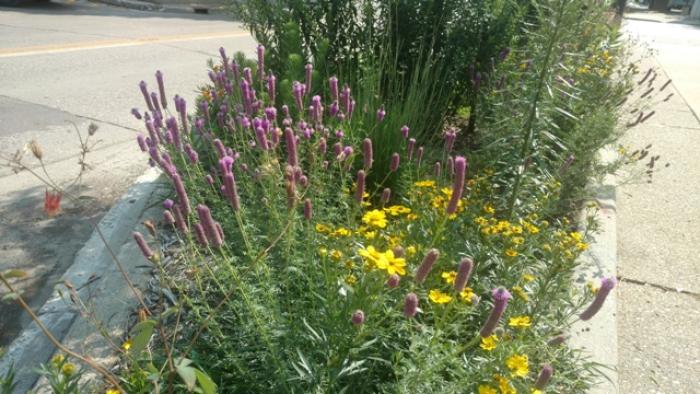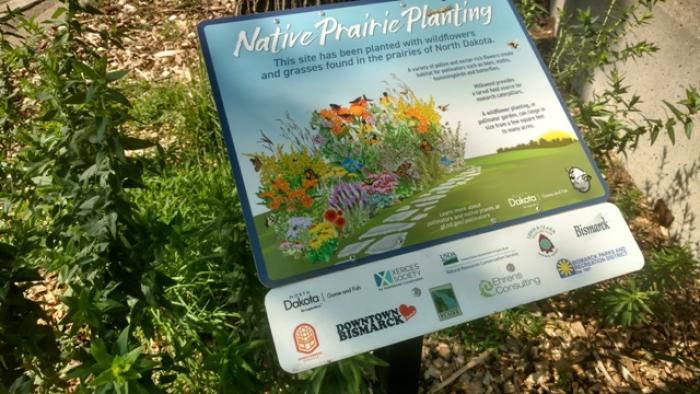Bismarck’s Buzzing with New Bee Habitat
A city might be the last place you’d think of as a good place to plant habitat for bees.
But the USDA Natural Resources Conservation Service of North Dakota has collaborated with private businesses and non-profit groups and federal, state and local government agencies to do just that – and it is paying dividends.
Landscapers planted native flowers in 10 small gardens in downtown Bismarck, N.D., in an area known as Chancellor Square. They used a variety of drought-resistant species that bloom in the early, mid and late season to ensure that pollen and nectar are available to pollinators throughout the growing season, even in a dry year. They also planted native bunchgrasses, which can provide shelter and over wintering habitat for pollinators.
Signs in the flower beds remind people of the importance of pollinators
“Honeybees, native bees, moths, butterflies, flies, wasps and beetles are essential pollinators, enabling the reproduction of more than 85% of all flowering plants. Our agricultural systems also rely on pollinators. In the U.S., pollinator dependent crops generate $18 to $27 billion annually”, says Sarah Hamilton Buxton, a Xerces pollinator conservation planner under a partnership agreement with North Dakota NRCS.
North Dakota is the top honey producing state in the U.S. There are approximately 300 registered beekeepers in North Dakota. Some have just one hive. Some are commercial honey producers who move their hives between North Dakota in the summer and California in the winter to pollinate crops and have as many 20,000 hives.
Unfortunately, populations of some pollinator species, especially wild ones, have been declining in recent years. Most scientists think that a loss of grasslands and other habitat, a rise in disease and the use of some agricultural pesticides are to blame. Recent research shows that up to 40% of invertebrate species on earth are in decline and may face extinction in the future.
“By creating, enhancing, and restoring pollinator habitat, we hope to reverse current declines in pollinator populations.,” Buxton says
Over the past eight years, NRCS has provided funds through U.S. Department of Agriculture’s Environmental Quality Incentive Program to plant pollinator habitat on more than 4,600 acres in rural North Dakota.
There’s a movement to establish urban pollinator habitat, too. Bee City USA and Bee Campus USA are initiatives of the Xerces Society for Invertebrate Conservation. The programs encourage communities to support pollinators by planting habitat in urban areas and on school and college campuses.
“While some pollinators depend on our vast acres of rangeland to survive, other pollinator species can complete their life cycles in small spaces. This is encouraging news because it means that folks living in towns and cities can contribute to pollinator conservation by planting habitat in flower beds and yards,” Buxton says
Beside NRCS-North Dakota other collaborators in the Downtown Bismarck Pollinator Planting Project include the Xerces Society, Lewis and Clark Wildlife Club, Downtown Business Association of Bismarck, Downtown Bismarck Community Foundation, Northern Plains National Heritage Area/Northern Plains Heritage Foundation, Dakota West Arts Council, Ehrens Consulting, Bismarck Parks and Recreation District, Burleigh County Soil Conservation District, and the city of Bismarck.
For more information about establishing pollinator habitat on your farm or ranch or in your community, contact your local NRCS office.


For high resolution images, click here.
Media contact:
Lon Tonneson
for the NRCS - North Dakota
lon.tonneson@gmail.com
701-361-1105

